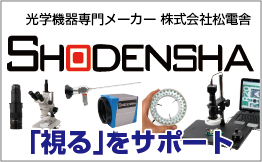The concept of “shutter” does not exist in industrial cameras as it does in consumer cameras. Instead, industrial cameras employ the idea of controlling “exposure time” and “frame rate” separately, rather than simply “taking a shutter shot.” The exposure time in industrial cameras is similar to the shutter speed of consumer cameras.
In the case of industrial cameras, the difference in exposure methods results in two categories: rolling shutter and global shutter.
Please consider this as a distinction based on the difference in exposure methods rather than a physical shutter.
The difference between rolling shutter and global shutter
<Rolling shutter>
Rolling shutter is also called “line exposure sequential readout”.
Collect one block from one line to one block and obtain the image for each block.
Combine this into one image. Although the inside of the block is simultaneous timing, a slight time difference occurs for each block.
CMOS cameras are generally rolling shutters.
(CMOS devices can read all pixels or read out partial images. Recently, cameras that can switch between rolling shutter and global shutter are also on sale.)
<Global shutter>
Global shutter is also called “simultaneous exposure all at once”.
Images are acquired at the simultaneous timing of all pixels.
CCD cameras are generally global shutters.
(Because the CCD element can not read out partly, it is inevitably a global shutter.)
Differentiating between rolling shutter and global shutter usage
I think that the following two points are important for practical use.
(1) When photographing a moving object
(2) When using strobe lighting
(1) When photographing a moving object
When capturing moving subjects, global shutter is more suitable.
(2) When using strobe lighting
If you use a camera with a rolling shutter for flash photography, there may be instances where only a part of the screen lights up or certain areas are not captured.
Let’s try capturing the subject in the photo below using a camera with a rolling shutter for flash photography.

 |
|
The phenomenon of certain parts not being captured. |
| |
|
|
 |
|
The phenomenon of only a specific portion being illuminated. |
When it comes to flash photography, global shutter is more suitable.
Considering the two points mentioned above, global shutter seems to be the better choice. However, rolling shutter also has its advantages.
The benefits of rolling shutter are as follows:
– Lower manufacturing cost
– Easier implementation of high resolution
■ Our Camera Lineup
– All of our high-resolution cameras with 10 million pixels or more are equipped with a rolling shutter.
– Our USB cameras come in 400,000 pixels, 1.3 million pixels, and 2 million pixels, all featuring a global shutter.
– We also offer global shutter models with 3.2 million pixels and 5 million pixels, but they are exclusively available in the GigE interface and come at a significantly higher price.
Allow us to introduce some of our cameras, including the global shutter models. (Please note that we have a wide range of other camera options available as well.)
<Global Shutter Camera Models>
| Name |
Color and Monochrome
|
Pixel count |
Shutter type |
FPS |
Interface |
Price (excluding tax) |
| CS41-C |
Color |
400,000 pixels |
Global |
120fps |
USB3.0 |
69,000 JPY |
| CS41-B |
Monochrome |
400,000 pixels |
Global |
120fps |
USB3.0 |
69,000JPY |
| CS500U-GC |
Color |
5MP |
Global |
59.8fps |
USB3.0 |
110,000JPY |
| EG320-C |
Color |
3.2 million pixels |
Global |
37.5fps |
GigE |
115,000JPY |
| EG320-B |
Monochrome |
3.2 million pixels |
Global |
37.5fps |
GigE |
115,000JPY |
| EG501-C |
Color |
5MP |
Global |
24.1fps |
GigE |
157,000JPY |
| EG500-B |
Monochrome |
5MP |
Global |
23.5fps |
GigE |
157,000JPY |
<Rolling Shutter Camera Models>
| Name |
Color and Monochrome
|
Pixel count |
Shutter type |
FPS |
Interface |
Price (excluding tax) |
| CS500-C |
Color |
5MP |
Rolling |
44.7fps |
USB3.0 |
71,000JPY |
| CS500-B |
Monochrome |
5MP |
Rolling |
31fps |
USB3.0 |
71,000JPY |
| CS1200-C |
Color |
12MP |
Rolling |
30fps |
USB3.0 |
99,000JPY |
| CS1200-B |
Monochrome |
12MP |
Rolling |
30fps |
USB3.0 |
99,000JPY |
| CS2000-C |
Color |
20MP |
Rolling |
14fps |
USB3.0 |
110,000JPY |
| CS2000-B |
Monochrome |
20MP |
Rolling |
14fps |
USB3.0 |
110,000JPY |
We have compiled a video summarizing the differences between rolling shutter and global shutter in our company. Please refer to the video for more information.
Summary:
In industrial cameras, rolling shutter and global shutter refer to the difference in exposure methods rather than physical shutters.
Rolling shutter, known as “line exposure sequential readout,” is commonly found in CMOS cameras.
Global shutter, known as “simultaneous exposure simultaneous readout,” is commonly found in CCD cameras.
(1) When capturing moving subjects and (2) when performing flash photography, global shutter is more suitable.

































































































